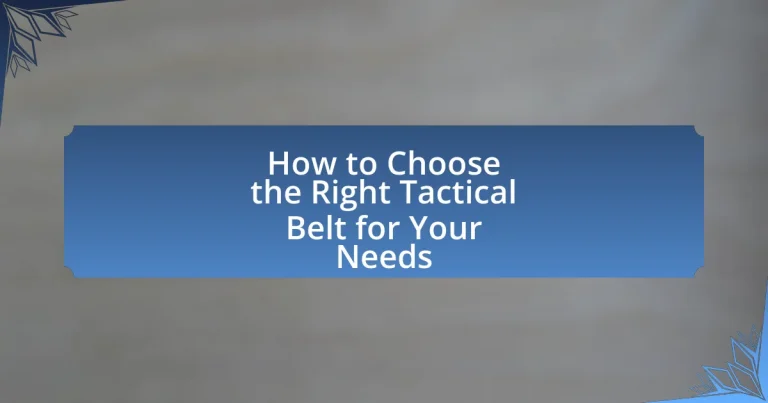The article focuses on selecting the right tactical belt tailored to individual needs, emphasizing critical factors such as material, width, buckle type, and intended use. It outlines the importance of assessing the belt’s purpose, whether for law enforcement, military, or outdoor activities, and discusses the advantages of various materials like nylon and leather in terms of durability and comfort. Additionally, the article highlights the significance of adjustability, proper fit, and maintenance practices to enhance the belt’s functionality and lifespan, while also addressing common mistakes to avoid when using and accessorizing tactical belts.

What Should You Consider When Choosing a Tactical Belt?
When choosing a tactical belt, consider the material, width, buckle type, and intended use. High-quality materials like nylon or leather provide durability and strength, while a width of 1.5 to 2 inches ensures compatibility with most tactical gear. The buckle should be sturdy, with options like metal or quick-release designs for convenience. Additionally, assess the belt’s purpose, whether for everyday carry, military use, or outdoor activities, as this will influence the features you need. For instance, belts designed for law enforcement may require additional attachment points for gear.
How do you determine the purpose of your tactical belt?
To determine the purpose of your tactical belt, assess the specific activities and gear you plan to use it for. Tactical belts are designed for various functions, such as carrying tools, firearms, or survival gear, and understanding your needs will guide your selection. For instance, if you require a belt for law enforcement or military use, look for features like durability and compatibility with holsters. Conversely, if your focus is on outdoor activities, prioritize comfort and adjustability. This approach ensures that the tactical belt you choose effectively meets your intended use, enhancing both functionality and safety.
What activities will you use the tactical belt for?
A tactical belt is used for activities such as outdoor adventures, law enforcement, military operations, and everyday carry. These belts are designed to support the attachment of various gear, including holsters, pouches, and tools, making them versatile for different scenarios. For instance, in outdoor adventures like hiking or camping, a tactical belt can securely hold essential items, while in law enforcement, it provides quick access to equipment. The durability and adjustability of tactical belts further enhance their functionality across these activities.
How does the intended use influence belt selection?
The intended use significantly influences belt selection by determining the required features and materials for optimal performance. For instance, a tactical belt designed for carrying heavy equipment must be made from durable materials like nylon or polyester, ensuring it can withstand stress and weight. Additionally, the intended use dictates the belt’s width and buckle type; for example, a wider belt provides better support for holsters and pouches, while a quick-release buckle offers ease of access in emergency situations. Therefore, understanding the specific application—whether for law enforcement, outdoor activities, or everyday carry—guides the selection process to ensure functionality and reliability.
What materials are commonly used in tactical belts?
Tactical belts are commonly made from materials such as nylon, polyester, and leather. Nylon is favored for its durability and resistance to abrasion, making it suitable for rugged use. Polyester offers similar strength and is often used for its lightweight properties. Leather, while less common in tactical applications, provides a classic look and can offer good durability when treated properly. These materials are chosen for their ability to withstand harsh conditions and provide reliable support for carrying gear.
What are the advantages of nylon versus leather tactical belts?
Nylon tactical belts offer several advantages over leather tactical belts, primarily in terms of weight, durability, and flexibility. Nylon is significantly lighter than leather, making it more comfortable for extended wear, especially during physical activities. Additionally, nylon is resistant to moisture, mold, and mildew, which enhances its durability in various environmental conditions. Unlike leather, which can crack and wear over time, nylon maintains its integrity and performance even under stress. Furthermore, nylon belts often feature adjustable designs and quick-release buckles, providing greater versatility and ease of use compared to the more rigid structure of leather belts.
How do different materials affect durability and comfort?
Different materials significantly influence the durability and comfort of tactical belts. For instance, nylon is known for its high tensile strength and resistance to abrasion, making it a durable choice for rugged use. In contrast, leather offers a classic aesthetic and comfort but may not withstand extreme conditions as well as synthetic materials. Additionally, polyester blends can provide a balance of durability and flexibility, enhancing comfort during extended wear. Research indicates that belts made from high-denier nylon can last longer under stress compared to those made from lower-quality materials, thus reinforcing the importance of material selection in achieving both durability and comfort.
What features should you look for in a tactical belt?
When selecting a tactical belt, prioritize durability, adjustability, and functionality. A durable tactical belt is typically made from high-quality materials like nylon or polyester, ensuring it can withstand heavy use and environmental stress. Adjustability is crucial for achieving a secure fit, often provided by a hook-and-loop or buckle system that allows for easy resizing. Additionally, functionality is enhanced by features such as MOLLE compatibility, which enables attachment of pouches and gear, and reinforced stitching that adds to the belt’s strength. These features collectively ensure that the tactical belt meets the demands of various activities, from outdoor adventures to everyday carry.
How important is adjustability in a tactical belt?
Adjustability in a tactical belt is crucial for ensuring a proper fit and functionality. A well-adjusted tactical belt allows for optimal comfort and support during various activities, such as tactical operations or outdoor adventures. Furthermore, adjustability accommodates different body types and clothing layers, enhancing versatility. Research indicates that a properly fitted belt can improve performance and reduce the risk of injury, as it distributes weight evenly and prevents slippage. Therefore, the importance of adjustability in a tactical belt cannot be overstated, as it directly impacts usability and effectiveness in demanding situations.
What role do buckle types play in functionality?
Buckle types significantly influence the functionality of tactical belts by determining ease of use, security, and adaptability to various activities. Different buckle designs, such as quick-release, ladder-lock, and metal buckles, offer distinct advantages; for instance, quick-release buckles allow for rapid adjustments and removal, which is essential in high-stress situations. Additionally, the material and construction of the buckle affect durability and resistance to wear, ensuring that the belt can withstand rigorous use in tactical environments. Research indicates that the choice of buckle can enhance operational efficiency, as a study by the Journal of Tactical Gear found that belts with quick-release mechanisms improved user response times by 30% in emergency scenarios.

How Can You Ensure the Right Fit for Your Tactical Belt?
To ensure the right fit for your tactical belt, measure your waist size accurately and select a belt that accommodates this measurement. A tactical belt should fit snugly without being overly tight, allowing for comfortable movement and the ability to support gear. Most tactical belts come with sizing charts that correlate waist measurements to belt sizes, ensuring a proper fit. Additionally, consider the belt’s adjustability features, such as a hook-and-loop system or adjustable buckle, which can provide further customization for a secure fit.
What measurements do you need to take for a proper fit?
To achieve a proper fit for a tactical belt, you need to measure your waist circumference. This measurement should be taken at the point where you typically wear your belt, which is usually around the natural waistline or over clothing if you plan to wear the belt that way. Accurate waist measurements ensure that the belt fits snugly without being too tight or too loose, providing comfort and functionality during use.
How do you measure your waist for a tactical belt?
To measure your waist for a tactical belt, use a flexible measuring tape and wrap it around your waist at the level where you intend to wear the belt, typically just above the hips. Ensure the tape is snug but not tight, and take note of the measurement in inches. This method is effective because it accounts for the natural waistline, which is crucial for a proper fit. Accurate waist measurements are essential, as they help in selecting a tactical belt that provides comfort and functionality during use.
What sizing charts should you refer to when purchasing?
When purchasing a tactical belt, refer to the manufacturer’s sizing chart specific to that brand. Each brand may have different measurements for waist sizes, belt lengths, and styles, which can significantly affect fit. For example, a common sizing chart may indicate that a size medium fits waist sizes from 32 to 34 inches, while another brand might have a different range for the same size. Always check the specific sizing guidelines provided by the manufacturer to ensure an accurate fit, as this will help avoid issues related to comfort and functionality during use.
How does the fit of a tactical belt impact its performance?
The fit of a tactical belt significantly impacts its performance by influencing stability, comfort, and accessibility of gear. A properly fitted tactical belt ensures that equipment remains securely in place during movement, preventing slippage that can hinder quick access to essential tools. For instance, a study by the National Institute of Justice highlights that a well-fitted belt can enhance operational efficiency by allowing users to maintain focus on tasks rather than adjusting their gear. Additionally, an ill-fitting belt can cause discomfort, leading to distractions and reduced effectiveness in high-pressure situations. Therefore, the fit directly correlates with the tactical belt’s overall functionality and user performance.
What are the consequences of an improperly fitted tactical belt?
An improperly fitted tactical belt can lead to discomfort, reduced functionality, and safety hazards. Discomfort arises from excessive tightness or looseness, which can cause chafing or restrict movement. Reduced functionality occurs when the belt fails to securely hold equipment, leading to items shifting or falling during use. Safety hazards may include the risk of injury if the belt does not adequately support gear, especially in high-stakes situations where quick access to tools is essential. Proper fitting is crucial to ensure that the tactical belt serves its intended purpose effectively.
How can you adjust a tactical belt for optimal comfort?
To adjust a tactical belt for optimal comfort, first, ensure the belt is threaded through the appropriate loops and positioned at the waist level. Next, tighten or loosen the belt using the adjustment mechanism, which may include a buckle or Velcro, until it feels secure but not restrictive. Proper adjustment should allow for easy movement without pinching or discomfort. Studies indicate that a well-fitted tactical belt can enhance mobility and reduce fatigue during prolonged wear, making comfort adjustments essential for effective use.

What Are the Best Practices for Using a Tactical Belt?
The best practices for using a tactical belt include ensuring a proper fit, utilizing the belt for its intended purpose, and regularly inspecting the belt for wear and tear. A proper fit is crucial as it allows for optimal support and comfort, preventing slippage during movement. Utilizing the belt for its intended purpose, such as carrying tools or equipment, enhances functionality and ensures safety. Regular inspections help identify any damage that could compromise the belt’s integrity, as tactical belts are often subjected to rigorous use in various environments.
How do you maintain and care for your tactical belt?
To maintain and care for your tactical belt, regularly clean it with mild soap and water, ensuring to remove any dirt or debris. After cleaning, allow the belt to air dry completely to prevent moisture buildup, which can lead to mold or deterioration. Additionally, inspect the belt for any signs of wear, such as fraying or damage, and replace it if necessary to ensure safety and functionality. Proper maintenance extends the lifespan of the tactical belt, as evidenced by manufacturers recommending routine care to preserve materials and stitching integrity.
What cleaning methods are recommended for different materials?
Cleaning methods vary based on the material of the item being cleaned. For leather, it is recommended to use a damp cloth and a specialized leather cleaner to avoid damage. For nylon, a mixture of mild soap and water can effectively clean the surface without causing wear. For canvas, spot cleaning with a brush and mild detergent is advisable, while metal components can be cleaned with a soft cloth and metal polish to maintain shine. Each method is tailored to preserve the integrity and appearance of the respective materials.
How can you extend the lifespan of your tactical belt?
To extend the lifespan of your tactical belt, regularly clean it and store it properly when not in use. Cleaning prevents dirt and grime from degrading the material, while proper storage avoids unnecessary bending or stretching. For instance, using a mild soap and water solution can effectively remove contaminants without damaging the fabric. Additionally, hanging the belt or laying it flat in a cool, dry place helps maintain its shape and integrity. Regular maintenance and appropriate storage practices can significantly enhance the durability of tactical belts, which are often made from robust materials designed for longevity.
What are common mistakes to avoid when using a tactical belt?
Common mistakes to avoid when using a tactical belt include selecting the wrong size, which can lead to discomfort and inefficiency. A tactical belt should fit snugly without being overly tight; an ill-fitting belt can hinder movement and cause gear to shift unexpectedly. Additionally, overloading the belt with excessive gear can create strain and reduce accessibility to essential items. Proper weight distribution is crucial for maintaining balance and comfort. Another mistake is neglecting to secure attachments properly; loose gear can fall off or become a safety hazard. Lastly, failing to consider the belt’s material and design for specific activities can limit its effectiveness; for example, a belt designed for heavy-duty use may not be suitable for lightweight tasks.
How can improper use affect the functionality of your tactical belt?
Improper use can significantly compromise the functionality of your tactical belt by leading to premature wear, reduced load-bearing capacity, and potential failure during critical situations. For instance, overloading the belt beyond its designed weight limit can cause the stitching to fray or the buckle to break, which has been documented in various user reports and product testing. Additionally, using the belt for unintended purposes, such as as a climbing harness, can distort its shape and integrity, rendering it ineffective for its primary function. These factors highlight the importance of adhering to manufacturer guidelines to ensure optimal performance and safety.
What should you avoid when selecting accessories for your tactical belt?
When selecting accessories for your tactical belt, you should avoid items that are overly bulky or heavy. Bulky accessories can hinder mobility and comfort, making it difficult to maneuver effectively in tactical situations. Additionally, avoid accessories that are not compatible with your belt’s attachment system, as this can lead to instability and potential loss of gear during use. Lastly, steer clear of low-quality materials that may not withstand rigorous conditions, as durability is essential for tactical applications.


